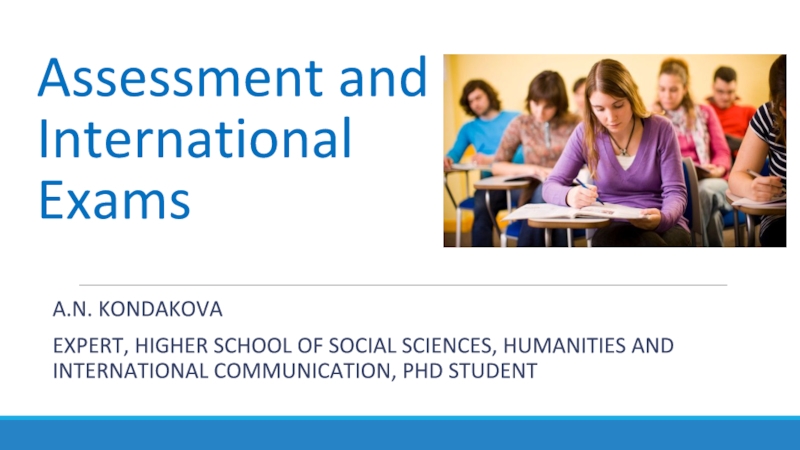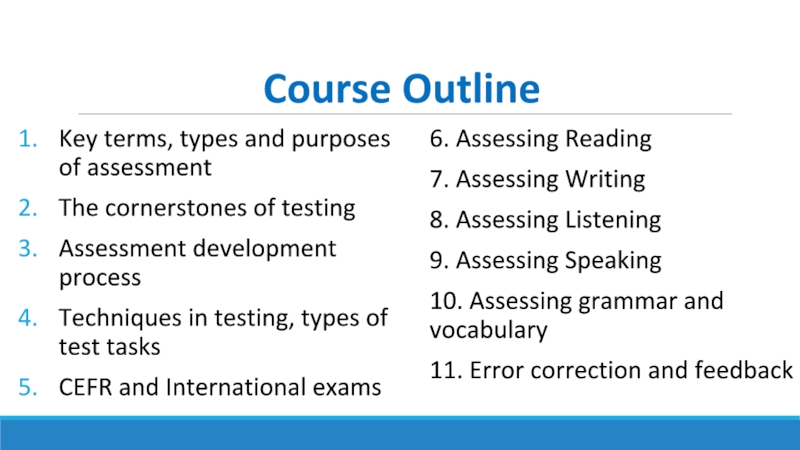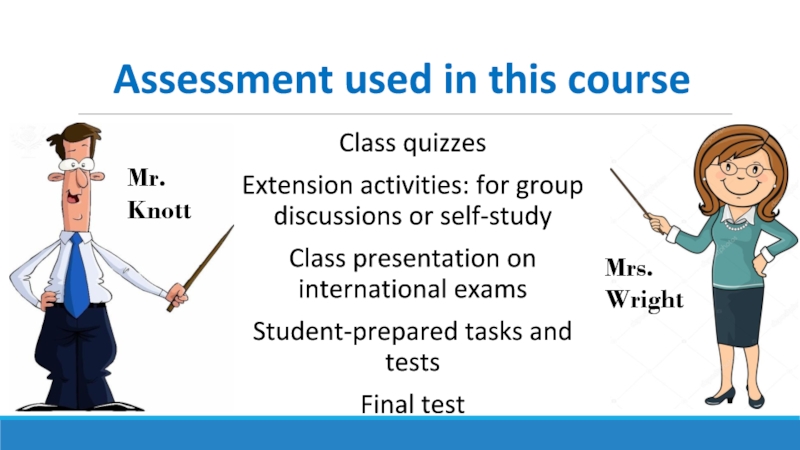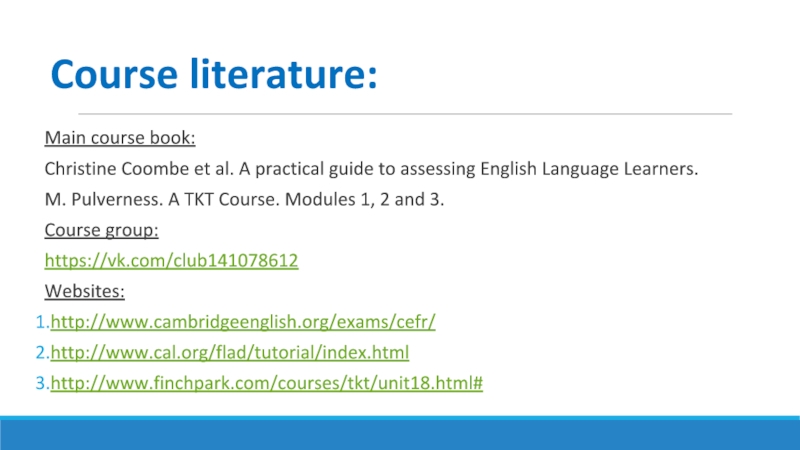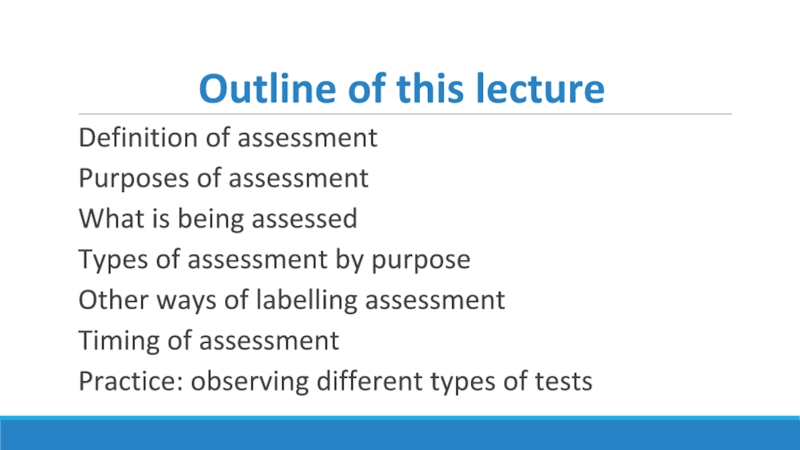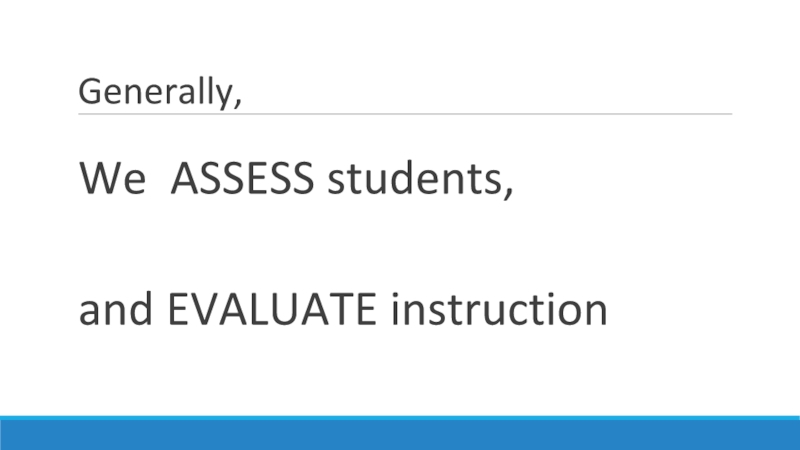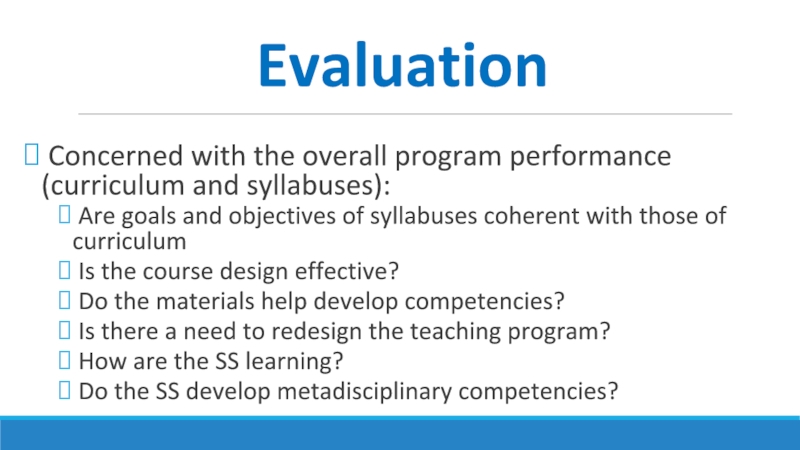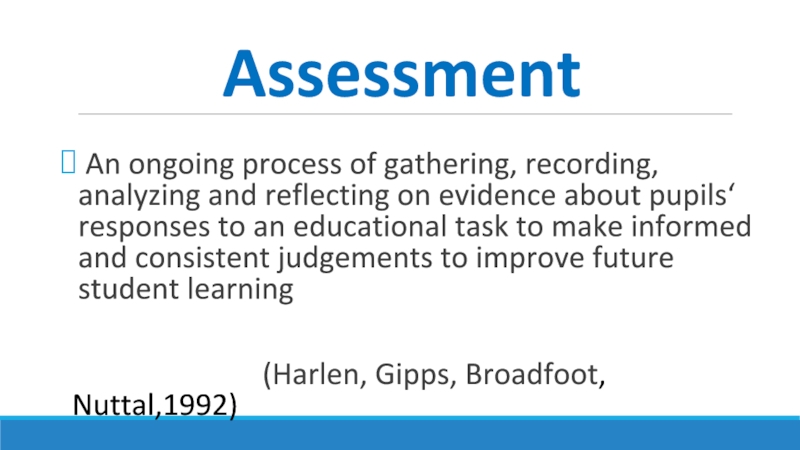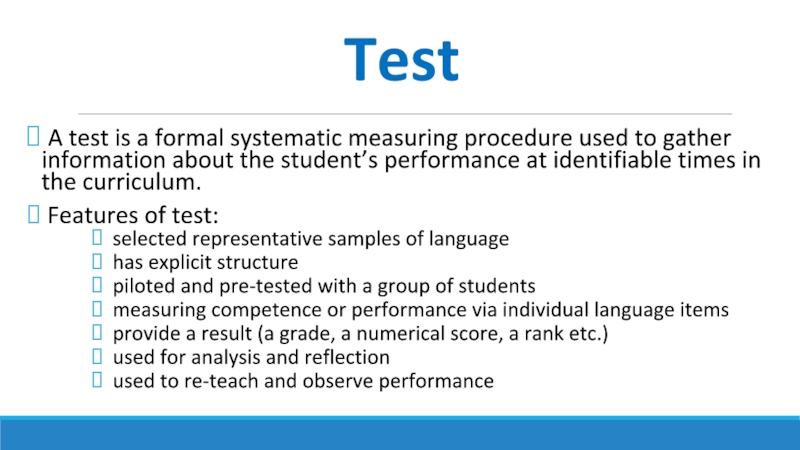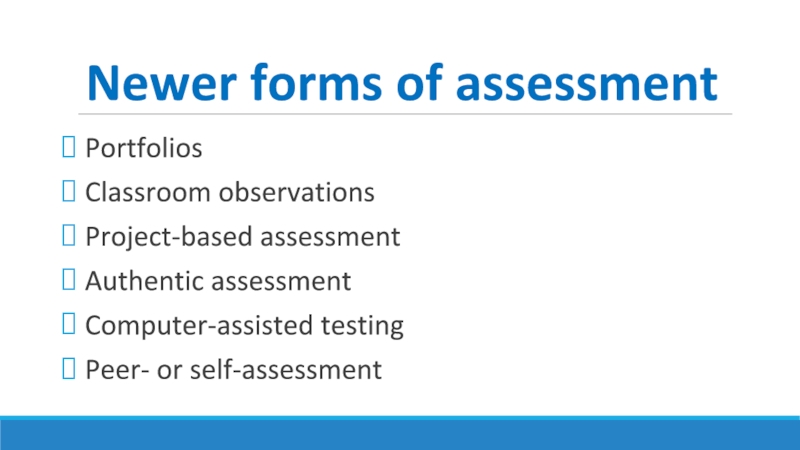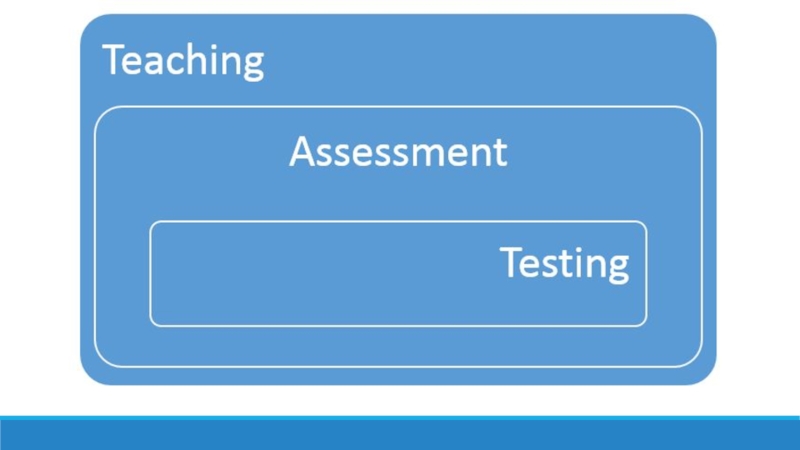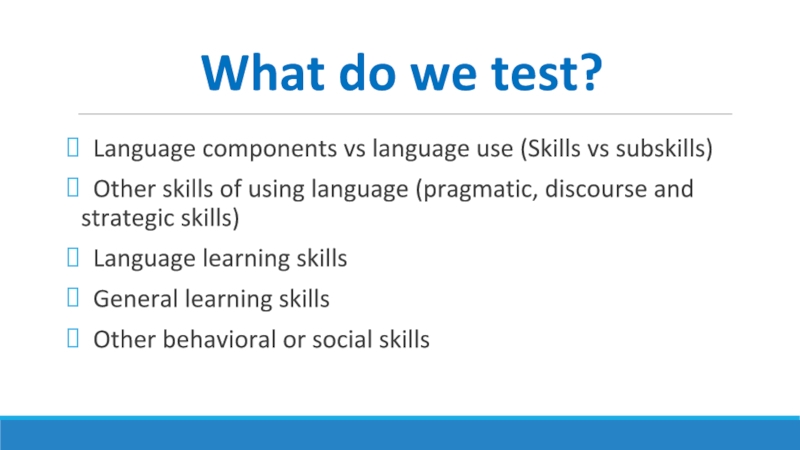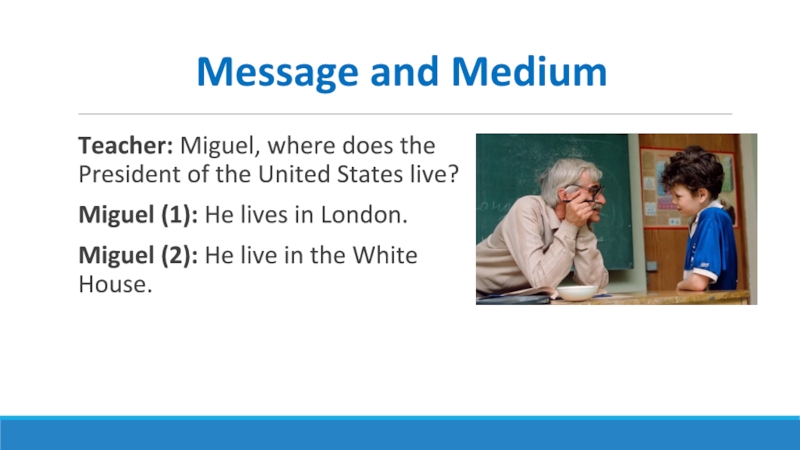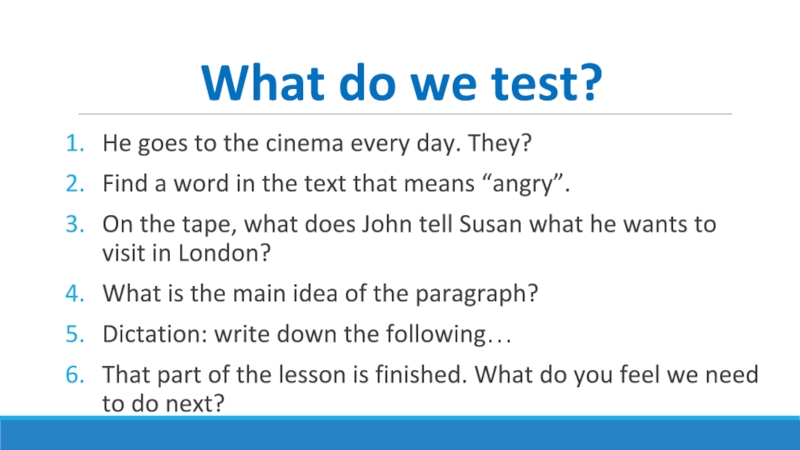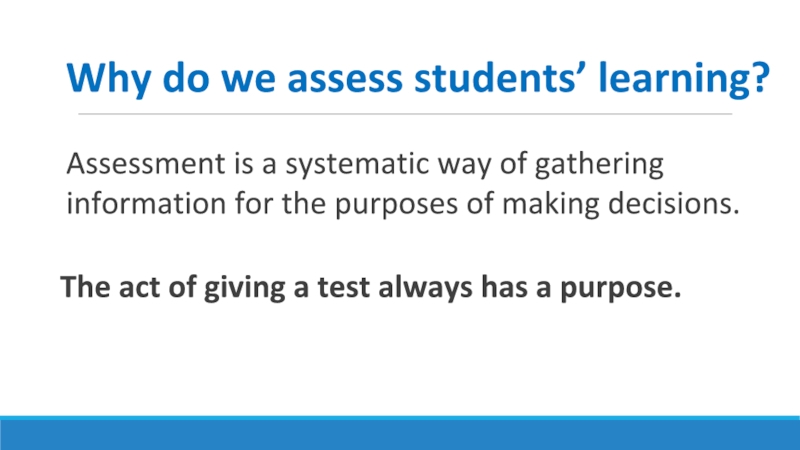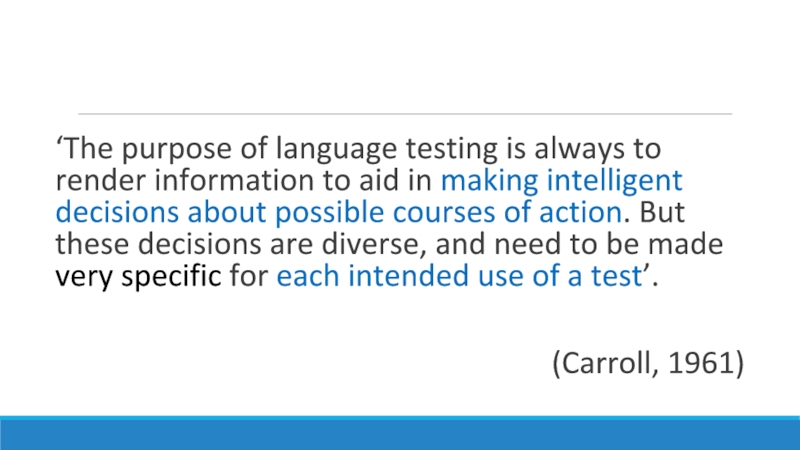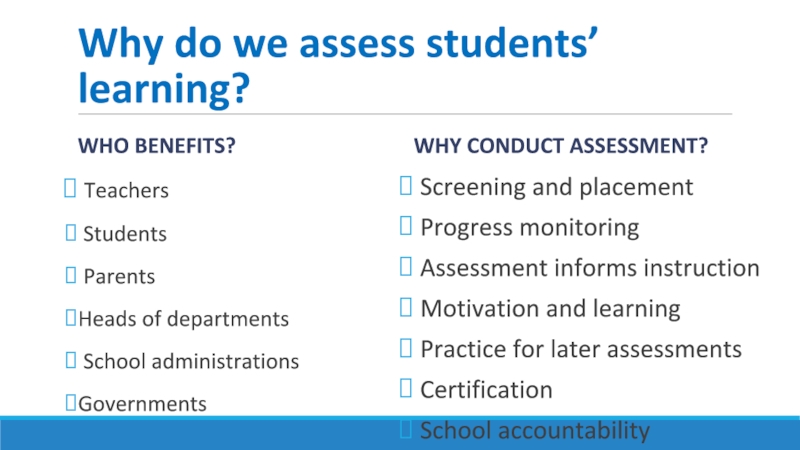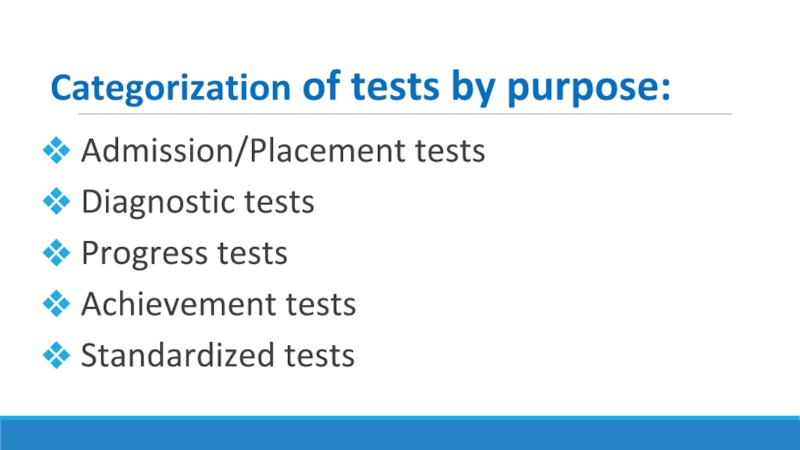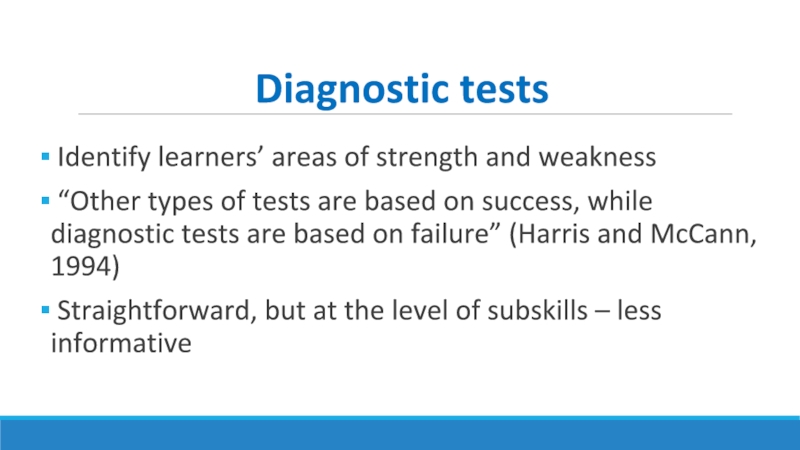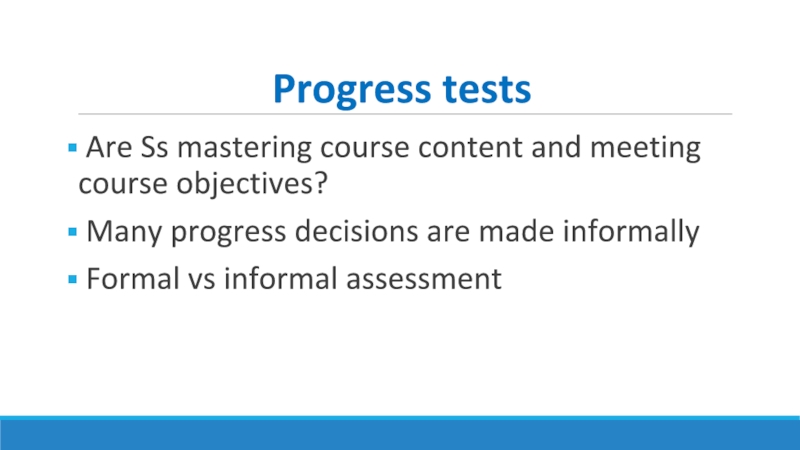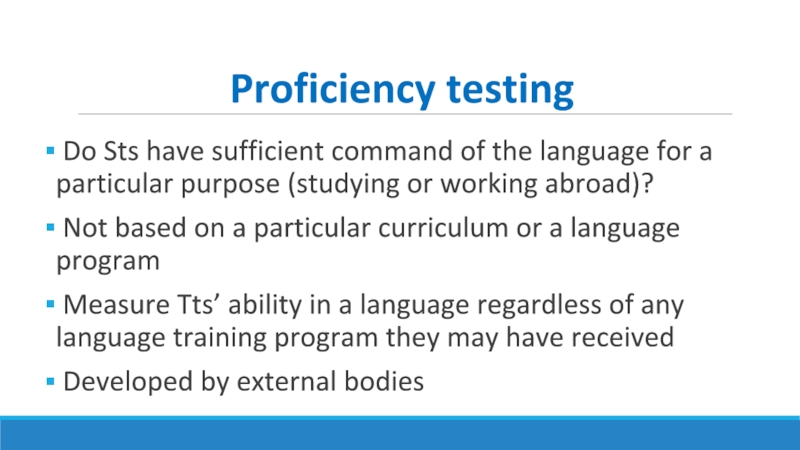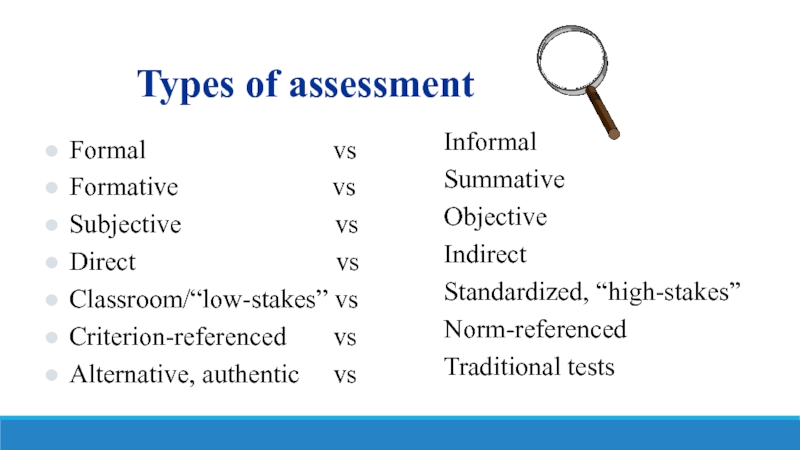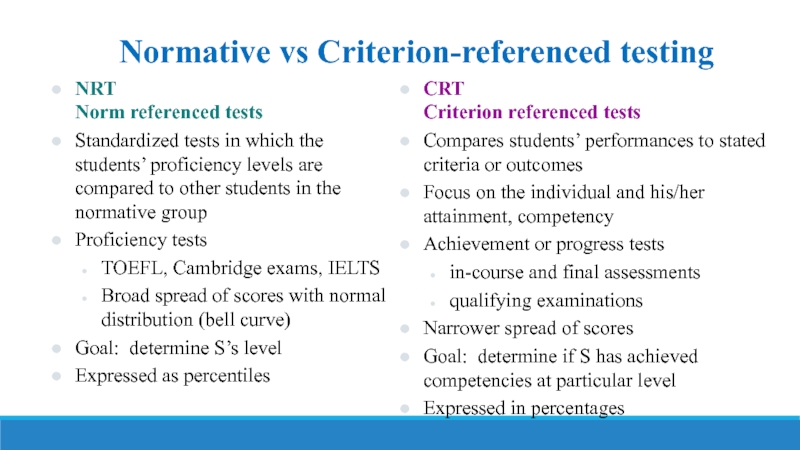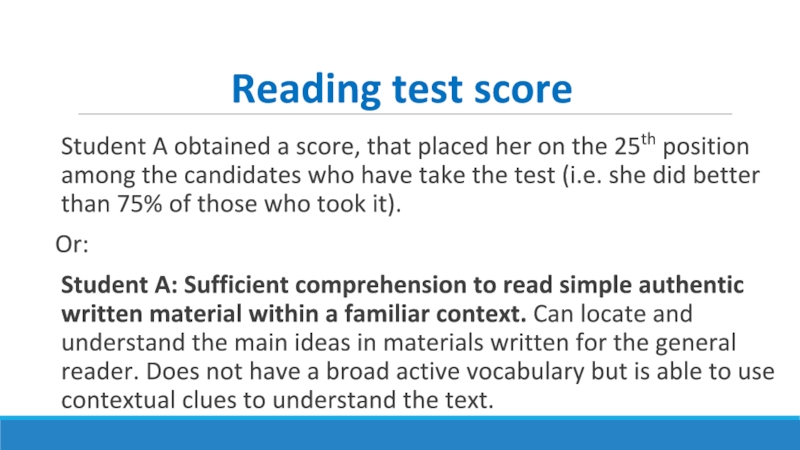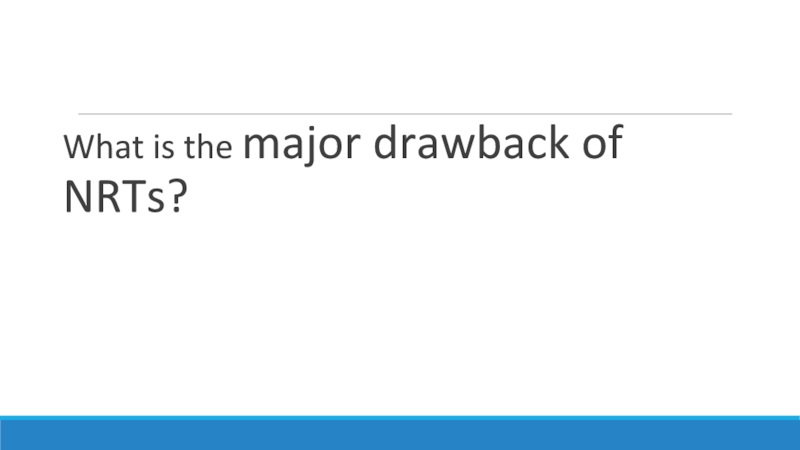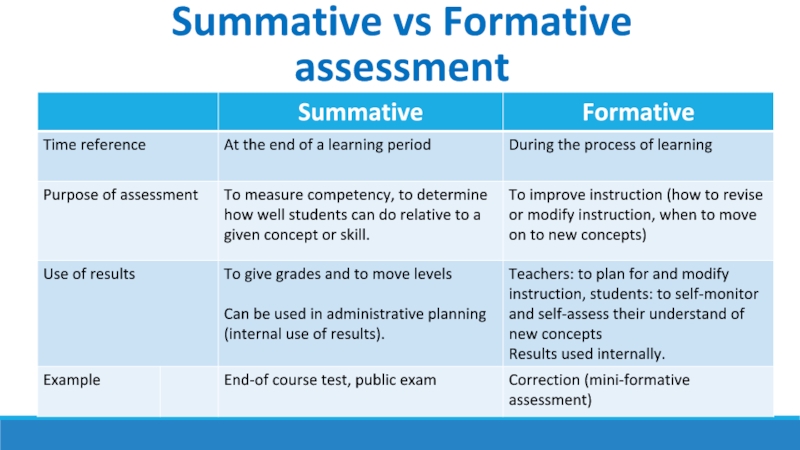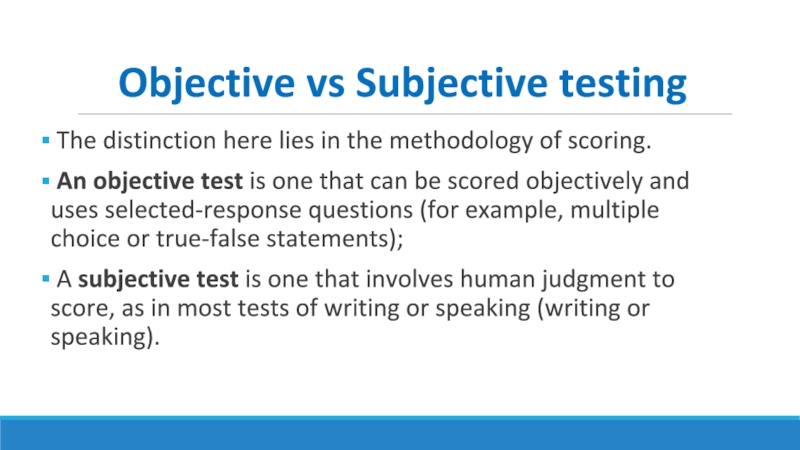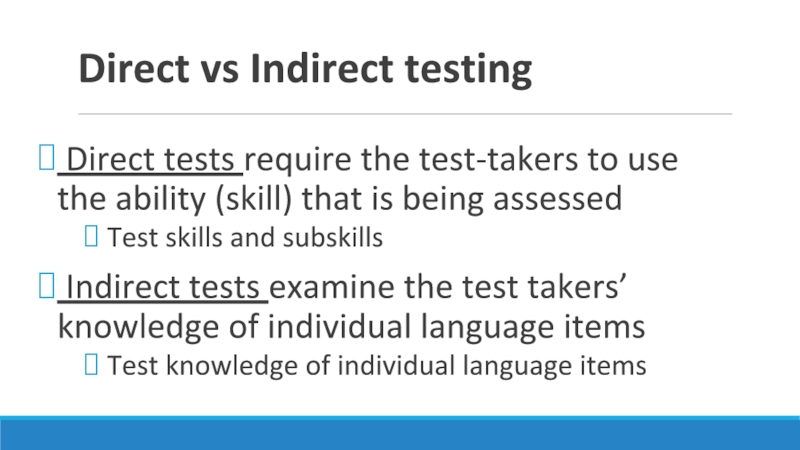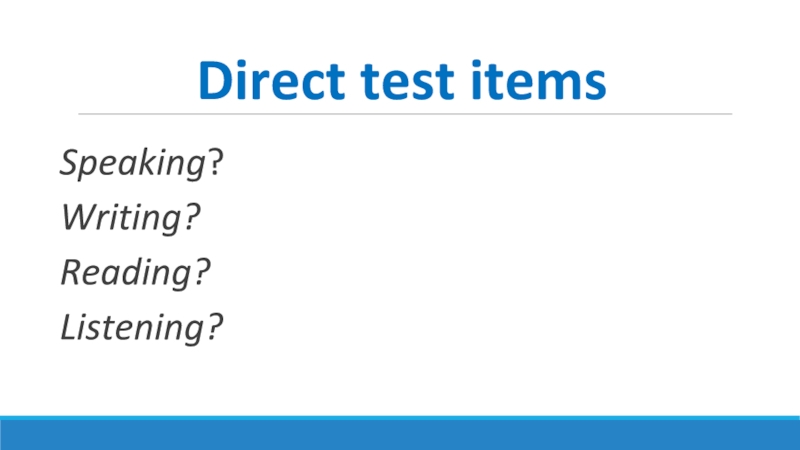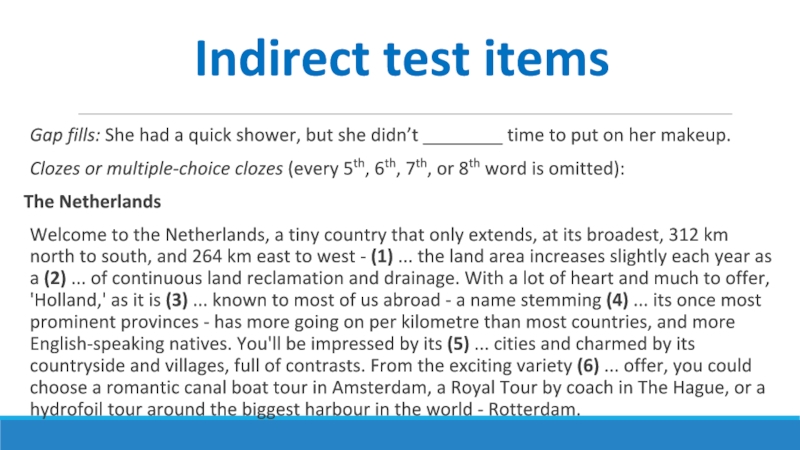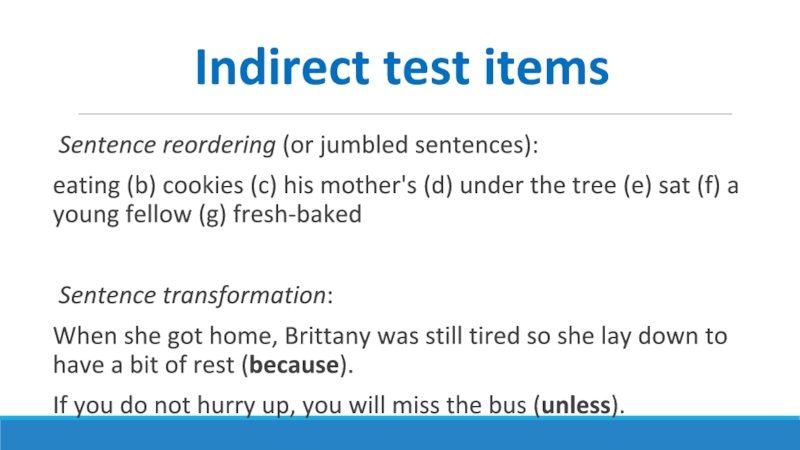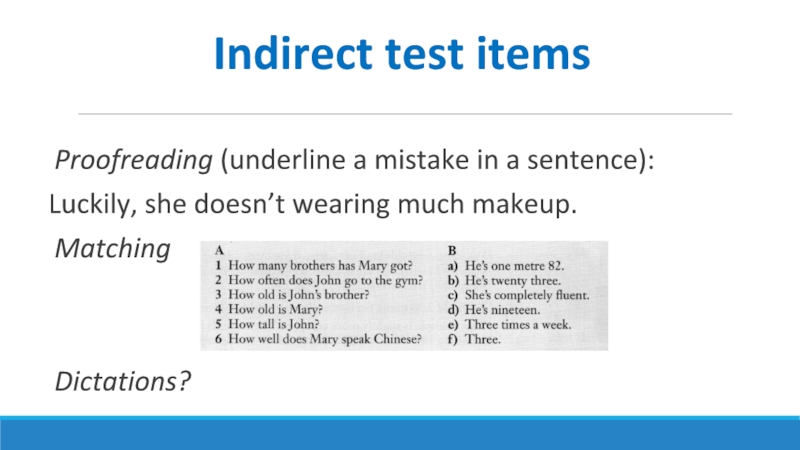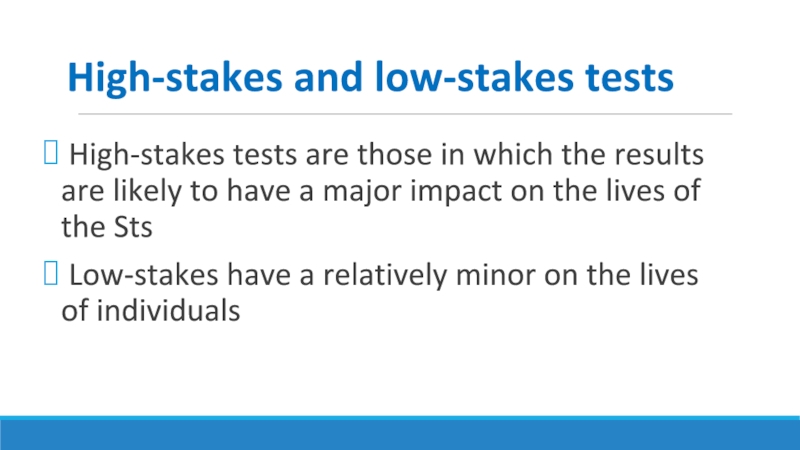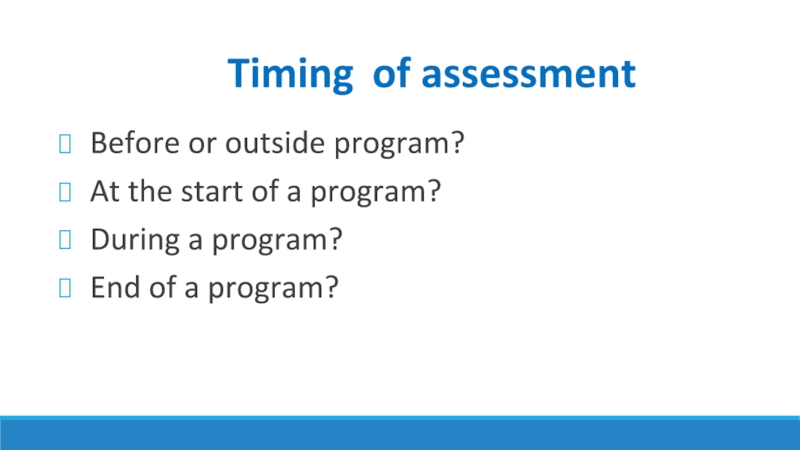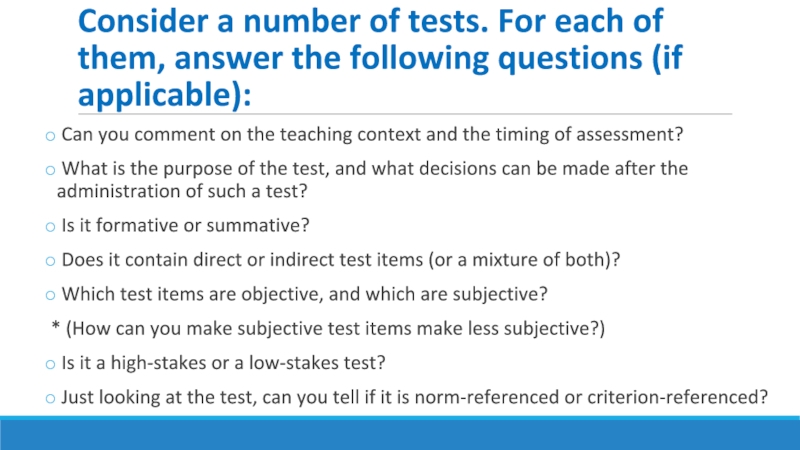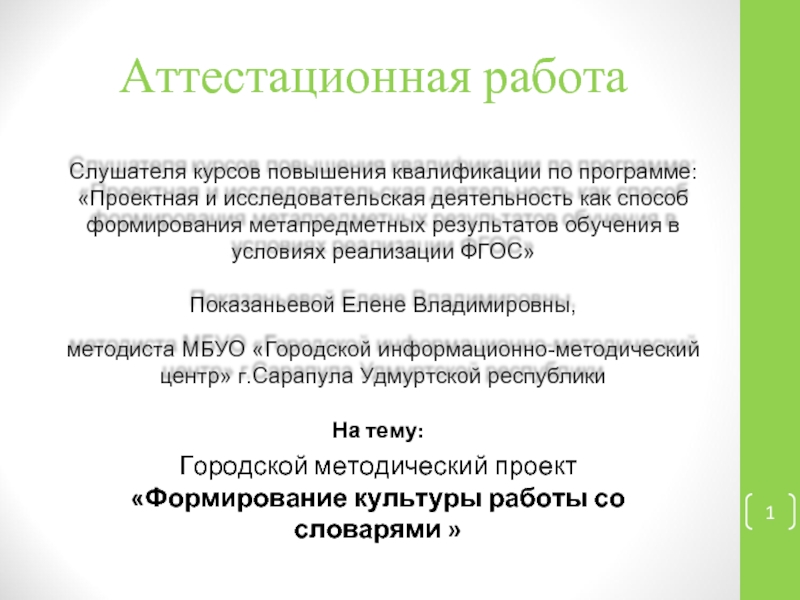- Главная
- Разное
- Дизайн
- Бизнес и предпринимательство
- Аналитика
- Образование
- Развлечения
- Красота и здоровье
- Финансы
- Государство
- Путешествия
- Спорт
- Недвижимость
- Армия
- Графика
- Культурология
- Еда и кулинария
- Лингвистика
- Английский язык
- Астрономия
- Алгебра
- Биология
- География
- Детские презентации
- Информатика
- История
- Литература
- Маркетинг
- Математика
- Медицина
- Менеджмент
- Музыка
- МХК
- Немецкий язык
- ОБЖ
- Обществознание
- Окружающий мир
- Педагогика
- Русский язык
- Технология
- Физика
- Философия
- Химия
- Шаблоны, картинки для презентаций
- Экология
- Экономика
- Юриспруденция
Assessment and International Exams презентация
Содержание
- 1. Assessment and International Exams
- 2. Course Outline Key terms, types and purposes
- 3. Assessment used in this course Class quizzes
- 4. Course literature: Main course book: Christine Coombe
- 5. Outline of this lecture Definition of assessment
- 6. Generally, We ASSESS students, and EVALUATE instruction
- 7. Evaluation Concerned with the overall program
- 8. Assessment An ongoing process of gathering,
- 9. Test A test is a formal
- 10. Newer forms of assessment Portfolios
- 12. What do we test? Language components
- 13. Message and Medium Teacher: Miguel, where
- 14. What do we test? He goes to
- 15. Assessment is a systematic way of gathering
- 16. ‘The purpose of language testing is always
- 17. Why do we assess students’ learning? WHO
- 18. Categorization of tests by purpose: Admission/Placement
- 19. Admission / Placement tests Should
- 20. Diagnostic tests Identify learners’ areas of
- 21. Progress tests Are Ss mastering course
- 22. Achievement tests How well have Ss
- 23. Proficiency testing Do Sts have sufficient
- 24. Types of assessment Formal
- 25. Normative vs Criterion-referenced testing NRT Norm
- 26. Reading test score Student A obtained a
- 27. What is the major drawback of NRTs?
- 28. Summative vs Formative assessment
- 29. Objective vs Subjective testing The distinction
- 30. Direct vs Indirect testing Direct tests
- 31. Direct test items Speaking? Writing? Reading? Listening?
- 32. Indirect test items Gap fills: She had
- 33. Indirect test items Sentence reordering (or jumbled
- 34. Indirect test items Proofreading (underline a mistake
- 35. High-stakes and low-stakes tests High-stakes tests
- 36. Timing of assessment Before or outside
- 37. Consider a number of tests. For each
Слайд 1Assessment and International Exams
A.N. KONDAKOVA
EXPERT, HIGHER SCHOOL OF SOCIAL SCIENCES, HUMANITIES
Слайд 2Course Outline
Key terms, types and purposes of assessment
The cornerstones of testing
Assessment
Techniques in testing, types of test tasks
CEFR and International exams
6. Assessing Reading
7. Assessing Writing
8. Assessing Listening
9. Assessing Speaking
10. Assessing grammar and vocabulary
11. Error correction and feedback
Слайд 3Assessment used in this course
Class quizzes
Extension activities: for group discussions or
Class presentation on international exams
Student-prepared tasks and tests
Final test
Mr. Knott
Mrs. Wright
Слайд 4Course literature:
Main course book:
Christine Coombe et al. A practical guide to
M. Pulverness. A TKT Course. Modules 1, 2 and 3.
Course group:
https://vk.com/club141078612
Websites:
http://www.cambridgeenglish.org/exams/cefr/
http://www.cal.org/flad/tutorial/index.html
http://www.finchpark.com/courses/tkt/unit18.html#
Слайд 5Outline of this lecture
Definition of assessment
Purposes of assessment
What is being assessed
Types
Other ways of labelling assessment
Timing of assessment
Practice: observing different types of tests
Слайд 7Evaluation
Concerned with the overall program performance (curriculum and syllabuses):
Are
Is the course design effective?
Do the materials help develop competencies?
Is there a need to redesign the teaching program?
How are the SS learning?
Do the SS develop metadisciplinary competencies?
Слайд 8Assessment
An ongoing process of gathering, recording, analyzing and reflecting on
(Harlen, Gipps, Broadfoot, Nuttal,1992)
Слайд 9Test
A test is a formal systematic measuring procedure used to
Features of test:
selected representative samples of language
has explicit structure
piloted and pre-tested with a group of students
measuring competence or performance via individual language items
provide a result (a grade, a numerical score, a rank etc.)
used for analysis and reflection
used to re-teach and observe performance
Слайд 10Newer forms of assessment
Portfolios
Classroom observations
Project-based assessment
Computer-assisted testing
Peer- or self-assessment
Слайд 12What do we test?
Language components vs language use (Skills vs
Other skills of using language (pragmatic, discourse and strategic skills)
Language learning skills
General learning skills
Other behavioral or social skills
Слайд 13Message and Medium
Teacher: Miguel, where does the President of the
Miguel (1): He lives in London.
Miguel (2): He live in the White House.
Слайд 14What do we test?
He goes to the cinema every day. They?
Find a word in the text that means “angry”.
On the tape, what does John tell Susan what he wants to visit in London?
What is the main idea of the paragraph?
Dictation: write down the following…
That part of the lesson is finished. What do you feel we need to do next?
Слайд 15Assessment is a systematic way of gathering information for the purposes
The act of giving a test always has a purpose.
Why do we assess students’ learning?
Слайд 16‘The purpose of language testing is always to render information to
(Carroll, 1961)
Слайд 17Why do we assess students’ learning?
WHO BENEFITS?
Teachers
Students
Parents
Heads of
School administrations
Governments
WHY CONDUCT ASSESSMENT?
Screening and placement
Progress monitoring
Assessment informs instruction
Motivation and learning
Practice for later assessments
Certification
School accountability
Слайд 18Categorization of tests by purpose:
Admission/Placement tests
Diagnostic tests
Progress tests
Standardized tests
Слайд 19Admission / Placement tests
Should a student be admitted to the
A single test might be used for both purposes: admission and placement
Commercially available, but will not readily suit any educational institution
Should be constructed for particular situation
Try this one: http://www.cambridgeenglish.org/test-your-english/
Слайд 20Diagnostic tests
Identify learners’ areas of strength and weakness
“Other types
Straightforward, but at the level of subskills – less informative
Слайд 21Progress tests
Are Ss mastering course content and meeting course objectives?
Formal vs informal assessment
Слайд 22Achievement tests
How well have Ss met course objectives or mastered
Accumulate the material from an entire course
Administered by ministries of education, official examining board or members of other teaching institutions
Слайд 23Proficiency testing
Do Sts have sufficient command of the language for
Not based on a particular curriculum or a language program
Measure Tts’ ability in a language regardless of any language training program they may have received
Developed by external bodies
Слайд 24Types of assessment
Formal
Formative vs
Subjective vs
Direct vs
Classroom/“low-stakes” vs
Criterion-referenced vs
Alternative, authentic vs
Informal
Summative
Objective
Indirect
Standardized, “high-stakes”
Norm-referenced
Traditional tests
Слайд 25Normative vs Criterion-referenced testing
NRT
Norm referenced tests
Standardized tests in which the
Proficiency tests
TOEFL, Cambridge exams, IELTS
Broad spread of scores with normal distribution (bell curve)
Goal: determine S’s level
Expressed as percentiles
CRT
Criterion referenced tests
Compares students’ performances to stated criteria or outcomes
Focus on the individual and his/her attainment, competency
Achievement or progress tests
in-course and final assessments
qualifying examinations
Narrower spread of scores
Goal: determine if S has achieved competencies at particular level
Expressed in percentages
Слайд 26Reading test score
Student A obtained a score, that placed her on
Or:
Student A: Sufficient comprehension to read simple authentic written material within a familiar context. Can locate and understand the main ideas in materials written for the general reader. Does not have a broad active vocabulary but is able to use contextual clues to understand the text.
Слайд 29Objective vs Subjective testing
The distinction here lies in the methodology
An objective test is one that can be scored objectively and uses selected-response questions (for example, multiple choice or true-false statements);
A subjective test is one that involves human judgment to score, as in most tests of writing or speaking (writing or speaking).
Слайд 30Direct vs Indirect testing
Direct tests require the test-takers to use
Test skills and subskills
Indirect tests examine the test takers’ knowledge of individual language items
Test knowledge of individual language items
Слайд 32Indirect test items
Gap fills: She had a quick shower, but she
Clozes or multiple-choice clozes (every 5th, 6th, 7th, or 8th word is omitted):
The Netherlands
Welcome to the Netherlands, a tiny country that only extends, at its broadest, 312 km north to south, and 264 km east to west - (1) ... the land area increases slightly each year as a (2) ... of continuous land reclamation and drainage. With a lot of heart and much to offer, 'Holland,' as it is (3) ... known to most of us abroad - a name stemming (4) ... its once most prominent provinces - has more going on per kilometre than most countries, and more English-speaking natives. You'll be impressed by its (5) ... cities and charmed by its countryside and villages, full of contrasts. From the exciting variety (6) ... offer, you could choose a romantic canal boat tour in Amsterdam, a Royal Tour by coach in The Hague, or a hydrofoil tour around the biggest harbour in the world - Rotterdam.
Слайд 33Indirect test items
Sentence reordering (or jumbled sentences):
eating (b) cookies (c) his
Sentence transformation:
When she got home, Brittany was still tired so she lay down to have a bit of rest (because).
If you do not hurry up, you will miss the bus (unless).
Слайд 34Indirect test items
Proofreading (underline a mistake in a sentence):
Luckily, she doesn’t
Matching
Dictations?
Слайд 35High-stakes and low-stakes tests
High-stakes tests are those in which the
Low-stakes have a relatively minor on the lives of individuals
Слайд 36Timing of assessment
Before or outside program?
At the start of
During a program?
End of a program?
Слайд 37Consider a number of tests. For each of them, answer the
Can you comment on the teaching context and the timing of assessment?
What is the purpose of the test, and what decisions can be made after the administration of such a test?
Is it formative or summative?
Does it contain direct or indirect test items (or a mixture of both)?
Which test items are objective, and which are subjective?
* (How can you make subjective test items make less subjective?)
Is it a high-stakes or a low-stakes test?
Just looking at the test, can you tell if it is norm-referenced or criterion-referenced?
